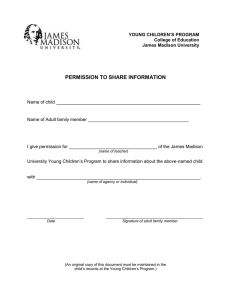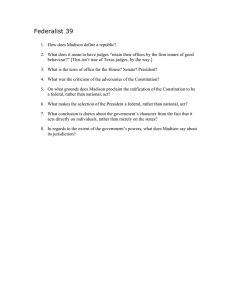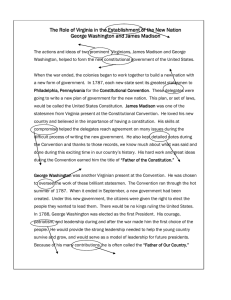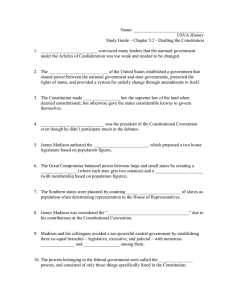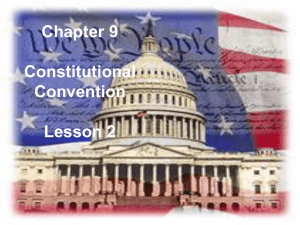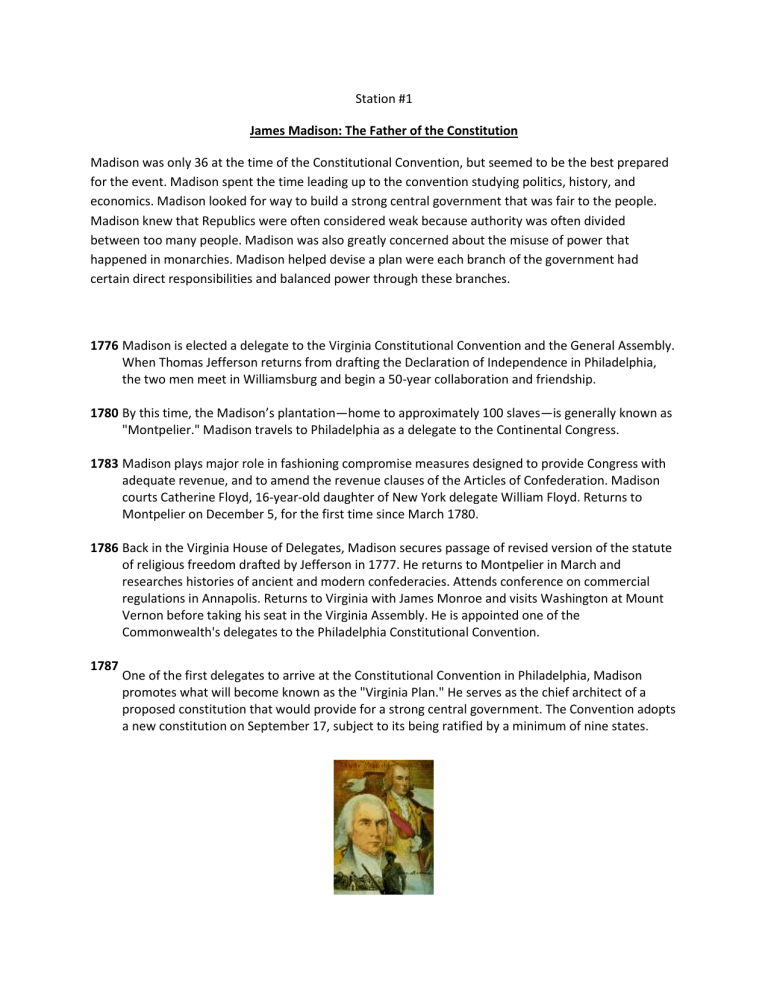
Station #1 James Madison: The Father of the Constitution Madison was only 36 at the time of the Constitutional Convention, but seemed to be the best prepared for the event. Madison spent the time leading up to the convention studying politics, history, and economics. Madison looked for way to build a strong central government that was fair to the people. Madison knew that Republics were often considered weak because authority was often divided between too many people. Madison was also greatly concerned about the misuse of power that happened in monarchies. Madison helped devise a plan were each branch of the government had certain direct responsibilities and balanced power through these branches. 1776 Madison is elected a delegate to the Virginia Constitutional Convention and the General Assembly. When Thomas Jefferson returns from drafting the Declaration of Independence in Philadelphia, the two men meet in Williamsburg and begin a 50-year collaboration and friendship. 1780 By this time, the Madison’s plantation—home to approximately 100 slaves—is generally known as "Montpelier." Madison travels to Philadelphia as a delegate to the Continental Congress. 1783 Madison plays major role in fashioning compromise measures designed to provide Congress with adequate revenue, and to amend the revenue clauses of the Articles of Confederation. Madison courts Catherine Floyd, 16-year-old daughter of New York delegate William Floyd. Returns to Montpelier on December 5, for the first time since March 1780. 1786 Back in the Virginia House of Delegates, Madison secures passage of revised version of the statute of religious freedom drafted by Jefferson in 1777. He returns to Montpelier in March and researches histories of ancient and modern confederacies. Attends conference on commercial regulations in Annapolis. Returns to Virginia with James Monroe and visits Washington at Mount Vernon before taking his seat in the Virginia Assembly. He is appointed one of the Commonwealth's delegates to the Philadelphia Constitutional Convention. 1787 One of the first delegates to arrive at the Constitutional Convention in Philadelphia, Madison promotes what will become known as the "Virginia Plan." He serves as the chief architect of a proposed constitution that would provide for a strong central government. The Convention adopts a new constitution on September 17, subject to its being ratified by a minimum of nine states. Station#2 The Virginia Plan vs The New Jersey Plan Before the convention had even met, James Madison and the other Virginia delegates developed what was called the Virginia Plan. This plan of government went way beyond the stated goals of the convention to revise the national government. It created an entirely new government which coincidentally, gave tremendous power to the larger states because voting was proportional to the number of inhabitants. Representatives from the smaller states had only hoped to revise the existing government under the Articles which gave each state an equal vote. All the delegates debated the Virginia Plan for over a week, when William Paterson introduced the New Jersey Plan. The ideas Paterson were a direct attack on the Virginia delegates plan. It preserved the structure of the current national government under the Articles but did allow for greater power to be rested in the national government. However, it did create an executive and judicial branch and enhance the power of Congress. New Jersey Plan The one house congress should continue to exist. The members will elect an Structure executive(s) who may only serve one term. A separate judicial branch consisting of one supreme court. Voting Each State has one vote in Congress Powers Virginia Plan The central government should consist of three branches, legislative (consisting of two houses), executive (elected by legislature one-term), and a judicial branch. Voting in both houses will be proportional to the number of free inhabitants of a state or the taxes paid by the state. Powers of the legislature should The legislature should be given the power include the power to force states to to collect taxes from the states. meet their obligations. At the end of the summer of 1787 the smaller states lead by New Jersey helped craft a constitution that protected the rights of the smaller states. This probably explains why The Constitution was ratified by New Jersey so quickly and was much harder to pass through larger state ratification conventions. The delegates debated, argued, threatened, and some left, but in the end a combination of the plans was created and became The Constitution. Station #3 The Great Compromise Connecticut delegate Roger Sherman is credited with proposing the alternative of a "bicameral," or twochambered Congress, made up of a Senate and a House of Representatives. Each state, suggested Sherman, would send an equal number of representatives to the Senate, and one representative to the House for each 30,000 residents of the state. At the time, all the states except Pennsylvania had bicameral legislatures, so the delegates were familiar with the structure of Congress proposed by Sherman. Sherman’s plan pleased delegates from both the large and small states and became known as the Connecticut Compromise of 1787, or the Great Compromise. Station#4 The Three-Fifths Compromise and a Bill of Rights Once the Connecticut Compromise settled that the seats in the House would be based on state population, the delegates argued over whether slaves should be counted in the populations of the southern states. Because their numbers were significant—with 90 percent of all slaves residing in Georgia, North Carolina, South Carolina, Maryland, and Virginia—most delegates from the slave-holding states argued that their numbers be factored. The North, however, disagreed. The result ended with the Three-Fifths Compromise, which determined that “threefifths of all other persons” would be counted; in other words, five slaves would instead be counted as three. This formula was also used to calculate the amount of money raised in each state by any direct tax levied by Congress. Another concern of the congress was protecting the rights of the people. A delegate from Virginia named George Mason proposed a bill of rights should be included with the constitution. Mason’s idea was later decided to be unnecessary. Later Mason and Elbrige Gerry refused to sign the constitution because there was no bill of rights. The Bill of Rights would later be added in 1791 Station #5 Signing the Constitution The convention finished their work on the Constitution in the late summer of 1787. On September 17, 1787 the delegates assembled in the Philadelphia State House to sign the document. Of the 55 delegates who helped with the convention only 39 sign it. The Constitution was then sent to the states for approval. Approval for the document was changed from the unanimous consent that was needed under the Articles of Confederation to 9 out of the 13 states. To help win the approval of the people James Madison, Alexander Hamilton, and John Jay wrote a series of essays supporting the Constitution. These essays became known as the federalist paper The Constitutional Convention Station #1: James Madison How old was Madison at the time of the convention? What problem did Madison see in a traditional republic? What problem did Madison see in a monarchy? What plan did Madison support at the convention? Station#2: The Virginia Plan v The New Jersey Plan Fill in the venn diagram below VA Plan Both NJ Plan Which plan would you support and why? Station #3: The Great Compromise What was the Great Compromise? Who Proposed the Great Compromise? Which state did not have a Bicameral Legislature before the Great Compromise? Station #4: The Three-Fifths Compromise and a Bill of Rights What was the 3/5’s Compromise? Why did the south want slaves to count towards their population? Who first proposed the idea of a Bill of Rights? Was his idea originally accepted? Even though the constitution is accepted in 1787, when is a bill of rights added? Station#5: Signing the Constitution When and where is the Constitution signed? How many delegates sign it? How many states were needed to put the constitution into effect? How did James Madison, Alexander Hamilton, and John Jay help persuade people to support the constitution?

![Quiz About [Your topic]](http://s2.studylib.net/store/data/010236459_1-eafee5cbeabd58360217625fb978acb5-300x300.png)
